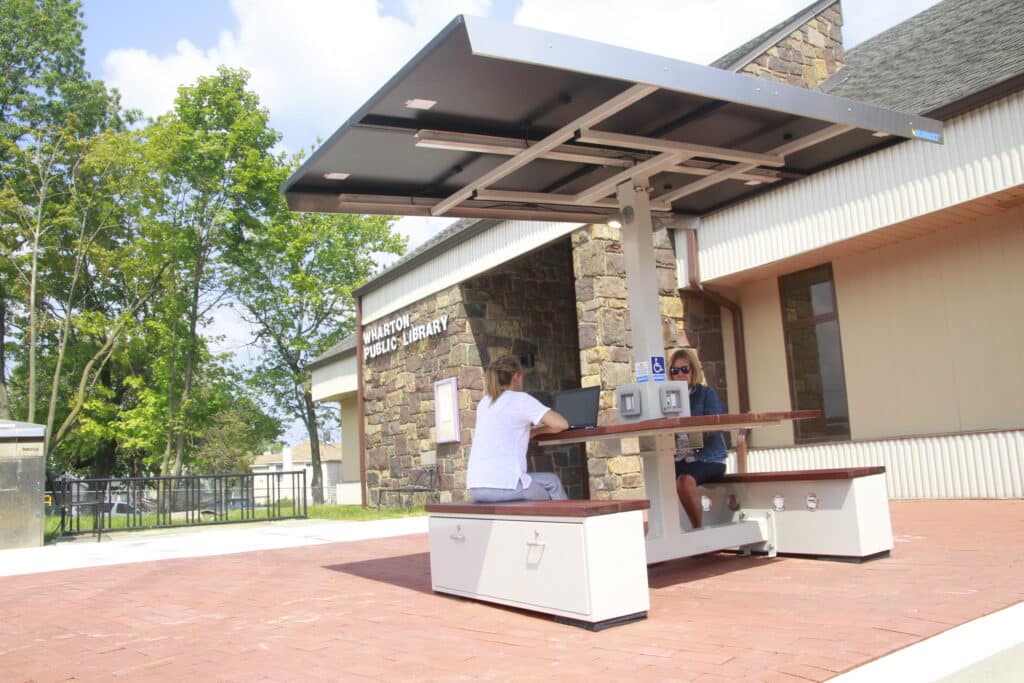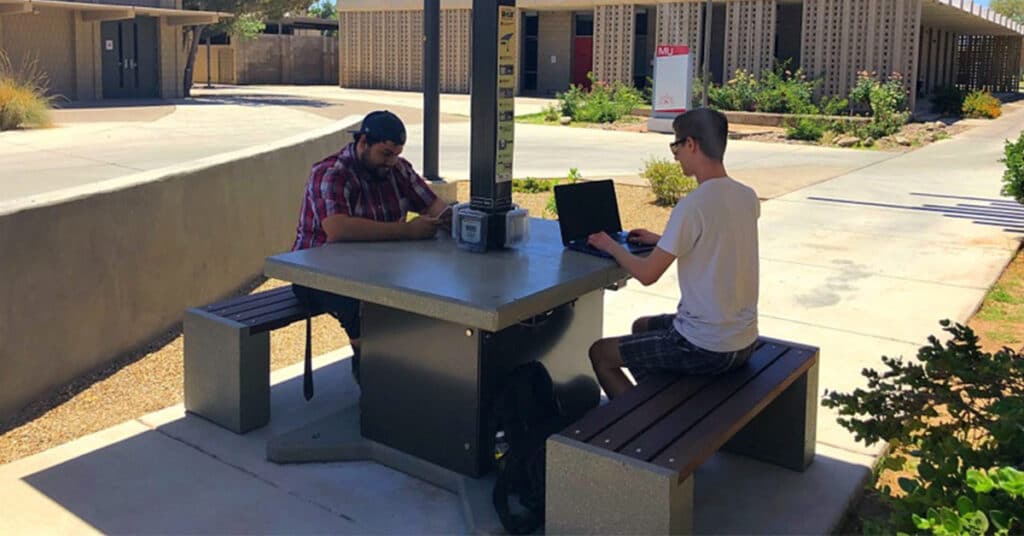As the need for sustainable energy solutions continues to grow, the popularity of solar power also blossoms. Solar panels convert sunlight into electricity, becoming a viable option for powering various devices and electronics. Sunbolt, the leader in solar integration, infuses the latest technology with innovation and durability, enhancing the outdoor charging experience.
Can solar panels power a laptop?
Definitely! Solar panels are composed of multiple photovoltaic (PV) cells connected to form a solar module. When sunlight hits the panel, photons from the sunlight dislodge electrons in the semiconductors, creating electrical currents. That generated power is in the form of Direct Current (DC). Some laptops have a USB Type-C charging port allowing the use of DC power as a power source.
If the laptop has this charging option, the use of a Charge Controller will regulate that flow of the electricity from the solar panel(s) to the laptop, maintaining the voltage and current at the appropriate levels. The majority of laptops require an Alternate Current (AC) provided by the addition of an inverter.
When considering solar power as a charging option, it is important to understand the power requirement of the laptop being charged. Laptops come with varying power requirements that are usually measured in watts. Smaller laptops, such as Chromebook, Ultrabook, and other lightweight models have charging wattages between 45 to 65 watts.
Larger laptops with 15-to-17-inch screens have charging wattages between 65 and 90 watts. High performance gaming laptops may exceed the 90 watts to accommodate the higher-powered components. To determine the charging wattage of a specific laptop model, refer to the specifications provided by the manufacturer. For more information on solar panels visit here.
How can you determine how much solar is required to charge a laptop?
After determining the power requirements for the laptop, increase that number by 20%. Example: If your laptop requires 45W, determine the increase by calculating 45W + (45W x .2) to identify the Minimum Solar Wattage (45W + 9 = 54W). Solar panels have different efficiency levels, which varies based on the manufacturer and reduces the older the solar panel becomes. That efficiency level will impact the charging time for the laptop.
WATCH: College students charge laptops using Sunbolt solar panel workstations:
How long will it take for a solar panel to charge a laptop?
The charging efficiency depends on factors such as the solar panel’s efficiency, the efficiency of the charging circuitry, and if a battery is included in the charging system. The average solar panel has a charging efficiency of 80%.
With these considerations, an estimation of the charging time for each laptop can be concluded. Using a 100W solar panel as a base for varying laptop power requirements you can approximate the following:
45W Laptop: Charging Time = (45W / 100W) / 0.8 = 0.5625 hours or approximately 34 minutes.
60W Laptop: Charging Time = (60W / 100W) / 0.8 = 0.75 hours or approximately 45 minutes.
90W Laptop: Charging Time = (90W / 100W) / 0.8 = 1.125 hours or approximately 1 hour and 8 minutes.
120W Laptop: Charging Time = (120W / 100W) / 0.8 = 1.5 hours or approximately 1 hour and 30 minutes.
Note: The presented charging times can vary based on fluctuations in sunlight, shading, environmental conditions, and the manufacturer of the solar panel. Having a battery storage system will play a huge role in reducing some of those inconsistencies.
What are the advantages of using battery storage with solar power?
While it is possible to use solar panels without battery storage, there are several advantages that give reason to incorporating batteries into a solar panel charging system.
- Connecting a battery system to solar panels provides storage for excess generated electricity. This will allow a more consistent and reliable power supply.
- The stored energy can be used during nighttime hours, and when environmental conditions make it difficult to utilize the sun.
- Provides a back-up power supply during power outages and emergencies.
- In areas with Time Of Use Electricity Plans having a reliable energy source that can be used during high demand periods when electricity rates are typically higher. This can reduce energy cost while maximizing financial benefits of solar power.
Sunbolt has mastered this concept with innovative solar integrated charging solutions that are equipped with Maximum Power Point Tracking (MPPT) DC to DC charge controllers that not only converts the highest voltage to charge a well balanced battery system; it also allows data monitoring.
Sunbolt has two major categories for solar charging solutions: DC output units and AC output units. The DC output units consist of the Solar Stand-Up Charging Solutions and Solar Carousels. The AC output units consist of the Solar Workstations.

What devices can Sunbolt’s Solar Stand-Up Charging Solutions and Solar Carousels power?
These DC units are equipped with 60W Type-C Power Delivery (PD) capable of charging laptops and other USB powered devices with a requirement of 65W or less such as:
- Smartphones – Most smartphones have relatively low power requirements and can be easily powered by a 60-watt USB charger.
- Laptops – Some lightweight or low-power laptops can be charged with a 60-watt USB charger. However, it is important to check the specific power requirements of your laptop to ensure compatibility. Some known laptops are:
- Apple* – MacBook (12″ Retina Late 2015-2017), MacBook Pro (13″ & 15″ Late 2016-2018), MacBook Air (2018)
- Acer – Chromebook (14,15 CB515-1HT-P39B, Spin 11 R751TN-C5P3, Spin 11 R751T-C4XP), Nitro 5 Gaming AN515-41-F6VS, Spin7 SP714-51, Swift 7
- Asus – Chromebook Flip C302CA, Pro B9440UA, Transformer Book T100HA, Zenbook (Zenbook, 3 UX390UA, 3 Deluxe UX490UA), ZenPad S 8.0
- Dell – Inspiron (13 2-in-1 737, 15 2-in-1 7569), Latitude (5285, 5289, 5580, E7370, 7275, 7285, 7389, E7480), Venue (8 Pro Pad, 11 Pro Pad), XPS (12 2-in-1 9250, 13 2-in-1 9365, 13 9350, 13 9360)
- Google – Chromebook Pixel 2 2015, Nexus (5X, 6P), Pixel (1, 1 XL, 2, 2 XL, C), Pixelbook
- HP – Chromebook 13, Elite x2, EliteBook (Folio G1, x360 1020 G2, 1040 G4), Envy 13-AD107TU, Pavilion x2, Pro (Tablet 608, x2), Spectre (13, x360 13″ w/ Thunderbolt 3, x360 15″ w/ Thunderbolt 3), x2 210 G2
- Huawei – MateBook (Standard, E, X, X Pro)
- Lenovo – Miix (720, T470 w/ Intel 7th Gen CPU), T570, ThinkPad (13″, E480, T480, X1 Carbon Gen 5, X1 Yoga Gen 2), X1 (Carbon 2017, Tablet, Yoga), X270 w/ Intel 7th Gen CPU, Yoga (720 13″, 910 14″, 920)
- Microsoft – Surface Book 2
- Razer – Blade (Late 2016 w/ Intel 6th Gen CPU, Stealth 2015 w/ Intel 6th Gen CPU)
- Samsung – Chromebook Plus, Galaxy (S8, Galaxy S8+, S9, S9+, Tab Pro S, Tab S3), Notebook 9 (Pen 13.3″, 9 Pro 13″, 9 Pro 15″)
- Tablets – Many tablets, including popular models like iPads and Android tablets.
- Portable Speakers
- Bluetooth Headphones/Earbuds
- Fitness Trackers and Smartwatches
- E-book Readers
- Portable Game Consoles: Some portable gaming devices, such as handheld consoles, including the Nintendo Switch.
What devices can Sunbolt’s Solar Workstations power?
The Solar Workstations are equipped with a solar array that exceeds 1.3kw, a battery storage system of 2400 watt-hours (Wh) and an inverter that provides a continuous power output of 500W. These solar charging solutions can power everything the Solar Stand-Ups and Solar Carousels can, and much more. Schools, businesses, municipalities, and other locations with outdoor areas gravitate to Sunbolt for that very reason.
Sunbolt’s Solar Workstations can seat 8+ and supply a reliable charging source for 8 laptops at once. This creates an off-grid outdoor classroom and workspace. Sunbolt’s main focus is powering laptops and mobile devices. The design and powering system will allow for seamless use during the hours with sunlight with a battery storage system that will provide a power source for 48 hours without sun.
If the battery’s storage depletes, it will only take 2.31 hours to fully charge the battery storage system. With that power output other devices with consumption requirements under 400W can also be used such as:
- Small electronics with an average power consumption of 50W can be powered with ease. A 2400Wh battery storage system can power these devices for approximately 48 hours (2400Wh / 50W = 48 hours).
- Medium-sized electronics like a television, desktop computer, microwave (low power), or a small refrigerator typically have power requirements ranging from 100W to 300W. Assuming an average power consumption of 200W for these devices, a solar workstation could power one medium-sized appliance at a time. Users can power the appliance for approximately 12 hours (2400Wh / 200W = 12 hours).
- Power tools: Power tools such as drills, small saws, or air compressors may have higher power requirements. If we assume an average power consumption of 400W for power tools, the 500W inverter would be able to power one power tool at a time. With a 24V 100Ah battery, you can power the power tool for approximately 6 hours (2400Wh / 400W = 6 hours).
Though other devices can be powered with Sunbolt’s Solar Workstations, it is recommended that they are only used to power laptops and other mobile devices. These are rough estimates, and actual charging times can vary based on different variables. Refer to user manuals, specifications, and experts from Sunbolt before powering any device that is not a laptop or mobile device.
When it comes to solar panels having the ability to charge laptops, the answer is yes. When it comes to who does it the best, the answer is Sunbolt. The technology used in Sunbolt’s solar charging solutions provides an ease and reliability to using solar power to charge laptops. For more information on charging capabilities or limitations contact Sunbolt at info@gosunbolt.com.


